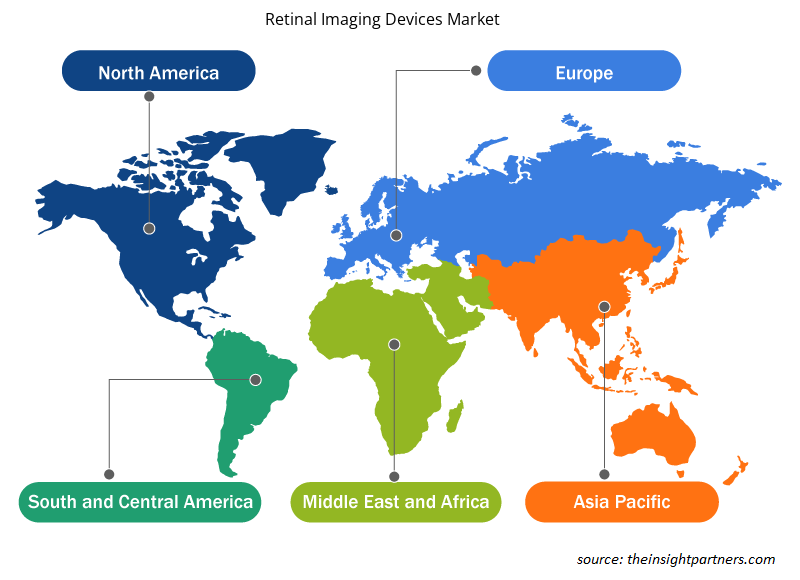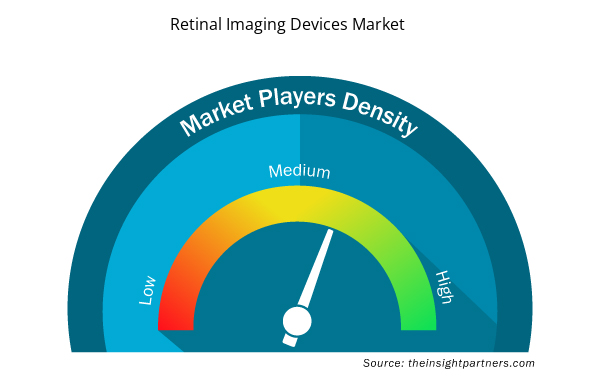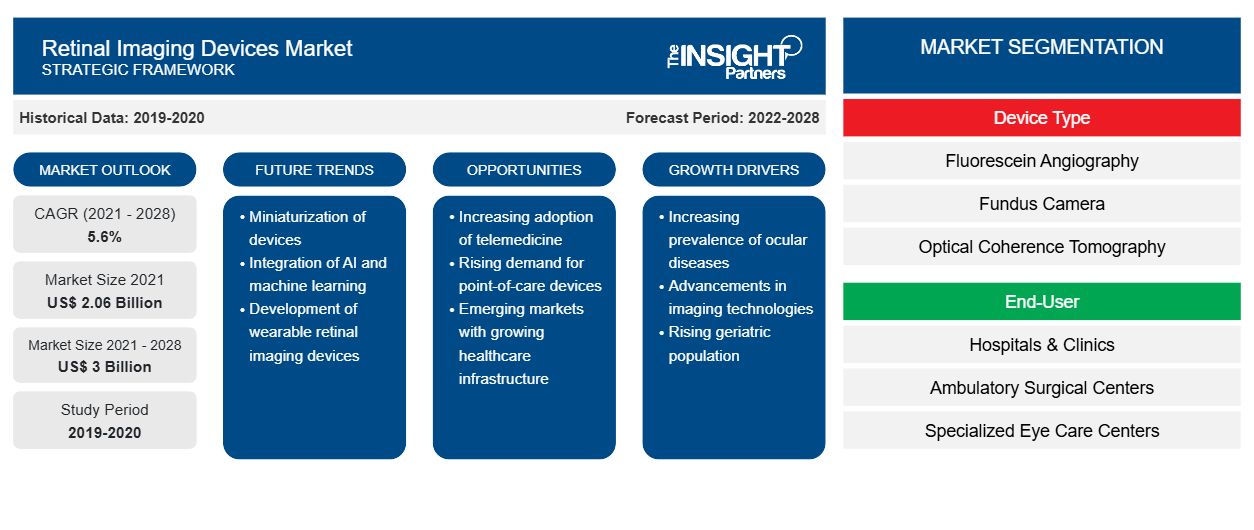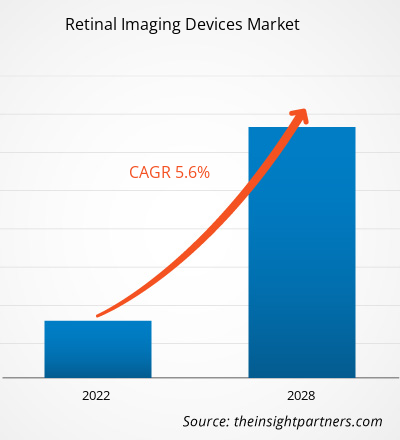Der Markt für Geräte zur Netzhautbildgebung soll von 2,06 Milliarden US-Dollar im Jahr 2021 auf 3,00 Milliarden US-Dollar im Jahr 2028 anwachsen; für den Zeitraum 2021–2028 wird mit einer durchschnittlichen jährlichen Wachstumsrate von 5,6 % gerechnet.
Die Netzhautbildgebung ist eine Technik, die zur Analyse und Diagnose des Zustands der Netzhaut eines Patienten verwendet wird. Netzhautbildgebungsgeräte (RID) verwenden hochauflösende Bildgebungssysteme, um Bilder des Inneren eines Auges aufzunehmen. Das aufgenommene Bild hilft Ärzten im Virtual Private Network (VSP), den Gesundheitszustand der Netzhaut zu beurteilen, was unter anderem bei der Erkennung und Behandlung von Augen- und Gesundheitszuständen wie Diabetes, Glaukom und Makuladegeneration hilft.
Passen Sie diesen Bericht Ihren Anforderungen an
Sie erhalten kostenlose Anpassungen an jedem Bericht, einschließlich Teilen dieses Berichts oder einer Analyse auf Länderebene, eines Excel-Datenpakets sowie tolle Angebote und Rabatte für Start-ups und Universitäten.
- Holen Sie sich die wichtigsten Markttrends aus diesem Bericht.Dieses KOSTENLOSE Beispiel umfasst eine Datenanalyse von Markttrends bis hin zu Schätzungen und Prognosen.
Das Wachstum des Marktes für Netzhautbildgebungsgeräte ist auf den verbesserten Zugang der Augenärzte zur Netzhaut, wachsende globale Initiativen zur Blindheitsbekämpfung und technologische Fortschritte zurückzuführen. Die hohen Kosten von OCT-Geräten hemmen jedoch das Marktwachstum.
Markteinblicke
Steigende Prävalenz von Augenkrankheiten
Netzhautbildgebungsgeräte werden häufig zur Diagnose und Behandlung verschiedener Augenkrankheiten wie diabetischer Retinopathie , altersbedingter Makuladegeneration, grünem Star, okulärem Melanom und leichten Sehproblemen eingesetzt. Darüber hinaus nimmt die Sorge um Blindheit oder Sehbehinderung weltweit stark zu. Laut den im Oktober 2021 von der Weltgesundheitsorganisation (WHO) veröffentlichten Daten leben fast 2,2 Milliarden Menschen mit einer Sehbehinderung oder Blindheit. Davon könnten etwa eine Milliarde Fälle von Sehbehinderung durch die richtige Diagnose und Behandlung verhindert werden. Diese eine Milliarde Menschen haben unterschiedliche Augenprobleme im Zusammenhang mit mittelschwerer oder schwerer Sehbehinderung oder Blindheit in der Ferne. Bildbezogene Diagnosetechnologien haben begonnen, ein beispielloses Wachstum bei Augenkrankheiten auf der Grundlage morphologischer Datensätze zu ermöglichen. Ein solcher Faktor dürfte dem Markt für Netzhautbildgebungsgeräte im Prognosezeitraum zugutekommen.
Gerätetypbasierte Erkenntnisse
Basierend auf dem Gerätetyp wurde der globale Markt für Geräte zur Netzhautbildgebung in Fluoreszenzangiografie, Funduskamera und optische Kohärenztomografie segmentiert. Das Segment Funduskamera hatte im Jahr 2021 den größten Marktanteil. Die Fundusfotografie hat sich von elektronischen Blitzen über Smartphone-basierte Kameras zu einem neueren tragbaren Augenuntersuchungsset (PEEK) gewandelt. PEEK ist eine Smartphone-basierte Anwendung für eine umfassende Augenuntersuchung. Der Vorteil dieser Kameras besteht darin, dass auch Nicht-Augenärzte Bilder aufnehmen und diese mit etwas Übung auch bewerten können. Es wird jedoch erwartet, dass das Segment der optischen Kohärenztomografie im Prognosezeitraum mit 8,1 % die höchste durchschnittliche jährliche Wachstumsrate auf dem Markt verzeichnen wird. Die optische Kohärenztomografie ermöglicht die Beurteilung verschiedener Grade der Makulaischämie, die bei der primären Bildgebung nicht diagnostiziert werden. Die Technik wird als Standard für Bildgebungsverfahren für Augen verwendet.
Endbenutzerbasierte Erkenntnisse
Basierend auf dem Endnutzer ist der globale Markt für Netzhautbildgebungsgeräte in Krankenhäuser und Kliniken, Fachkliniken, ambulante Pflegezentren und andere unterteilt. Das Segment Krankenhäuser und Kliniken hatte 2021 den größten Marktanteil, und spezialisierte Augenpflegezentren werden im Prognosezeitraum voraussichtlich die höchste durchschnittliche jährliche Wachstumsrate (CAGR) von 6,6 % auf dem Markt verzeichnen.
Regionale Einblicke in den Markt für Netzhautbildgebungsgeräte
Die regionalen Trends und Faktoren, die den Markt für Netzhautbildgebungsgeräte während des Prognosezeitraums beeinflussen, wurden von den Analysten von Insight Partners ausführlich erläutert. In diesem Abschnitt werden auch die Marktsegmente und die Geografie von Netzhautbildgebungsgeräten in Nordamerika, Europa, im asiatisch-pazifischen Raum, im Nahen Osten und Afrika sowie in Süd- und Mittelamerika erörtert.

- Erhalten Sie regionale Daten zum Markt für Netzhautbildgebungsgeräte
Umfang des Marktberichts zu Geräten zur Netzhautbildgebung
| Berichtsattribut | Details |
|---|---|
| Marktgröße im Jahr 2021 | 2,06 Milliarden US-Dollar |
| Marktgröße bis 2028 | 3 Milliarden US-Dollar |
| Globale CAGR (2021 - 2028) | 5,6 % |
| Historische Daten | 2019-2020 |
| Prognosezeitraum | 2022–2028 |
| Abgedeckte Segmente | Nach Gerätetyp
|
| Abgedeckte Regionen und Länder | Nordamerika
|
| Marktführer und wichtige Unternehmensprofile |
|
Dichte der Marktteilnehmer für Netzhautbildgebungsgeräte: Auswirkungen auf die Geschäftsdynamik verstehen
Der Markt für Netzhautbildgebungsgeräte wächst rasant, angetrieben durch die steigende Endverbrauchernachfrage aufgrund von Faktoren wie sich entwickelnden Verbraucherpräferenzen, technologischen Fortschritten und einem größeren Bewusstsein für die Vorteile des Produkts. Mit steigender Nachfrage erweitern Unternehmen ihr Angebot, entwickeln Innovationen, um die Bedürfnisse der Verbraucher zu erfüllen, und nutzen neue Trends, was das Marktwachstum weiter ankurbelt.
Die Marktteilnehmerdichte bezieht sich auf die Verteilung der Firmen oder Unternehmen, die in einem bestimmten Markt oder einer bestimmten Branche tätig sind. Sie gibt an, wie viele Wettbewerber (Marktteilnehmer) in einem bestimmten Marktraum im Verhältnis zu seiner Größe oder seinem gesamten Marktwert präsent sind.
Die wichtigsten auf dem Markt für Netzhautbildgebungsgeräte tätigen Unternehmen sind:
- Carl Zeiss Meditec
- Revenio Group Oyj
- Nikon Corporation
- Optomed
- Topcon Corporation
Haftungsausschluss : Die oben aufgeführten Unternehmen sind nicht in einer bestimmten Reihenfolge aufgeführt.

- Überblick über die wichtigsten Akteure auf dem Markt für Netzhautbildgebungsgeräte
Regionale Einblicke
Nach Regionen betrachtet hatte Nordamerika im Jahr 2021 den größten Anteil und dürfte im Prognosezeitraum einen ähnlichen Trend aufweisen. Die Region Asien-Pazifik dürfte im Prognosezeitraum die höchste Wachstumsrate aufweisen. Der Einsatz künstlicher Intelligenz (KI) und Deep-Learning-Systeme (DLS) zur Verbesserung der Screening-Abdeckung in Singapur dürfte das regionale Wachstum in den nächsten sieben Jahren unterstützen.
Produkteinführungen und -zulassungen sind häufig von Unternehmen eingesetzte Strategien, um ihre globale Präsenz und ihr Produktportfolio zu erweitern. Darüber hinaus konzentrieren sich die Marktteilnehmer für Netzhautbildgebungsgeräte auf die Partnerschaftsstrategie, um ihren Kundenstamm zu erweitern, was ihnen wiederum ermöglicht, ihren Markennamen weltweit aufrechtzuerhalten.
Basierend auf dem Gerätetyp wird der Markt für Netzhautbildgebungsgeräte in Fluoreszenzangiographie, Funduskamera und optische Kohärenztomographie unterteilt. Basierend auf dem Endverbraucher wird der Markt in Krankenhäuser und Kliniken, ambulante chirurgische Zentren, spezialisierte Augenpflegezentren und andere Endverbraucher segmentiert. Geografisch ist der Markt für Geräte zur Netzhautbildgebung segmentiert in Nordamerika (USA, Kanada und Mexiko), Europa (Großbritannien, Deutschland, Frankreich, Italien, Spanien und übriges Europa), Asien-Pazifik (China, Japan, Indien, Australien, Südkorea und übriger Asien-Pazifik-Raum), Naher Osten und Afrika (VAE, Saudi-Arabien, Südafrika und übriger Naher Osten und Afrika) sowie Süd- und Mittelamerika (Brasilien, Argentinien und übriges Süd- und Mittelamerika). Zu den in unserem Forschungsbereich aufgeführten Unternehmensprofilen zählen unter anderem Carl Zeiss Meditec, Revenio Group Oyj, Nikon Corporation, Optomed, Topcon Corporation, Imagine Eyes, Epipole Ltd, Forus Health Pvt Ltd, Eyenuk Inc und Phoenix Technology Group LLC.
- Historische Analyse (2 Jahre), Basisjahr, Prognose (7 Jahre) mit CAGR
- PEST- und SWOT-Analyse
- Marktgröße Wert/Volumen – Global, Regional, Land
- Branche und Wettbewerbsumfeld
- Excel-Datensatz



Report Coverage
Revenue forecast, Company Analysis, Industry landscape, Growth factors, and Trends

Segment Covered
This text is related
to segments covered.

Regional Scope
North America, Europe, Asia Pacific, Middle East & Africa, South & Central America

Country Scope
This text is related
to country scope.
Häufig gestellte Fragen
The global retinal imaging devices market is expected to reach US$ 3,009.55 million by 2028 from US$ 2,060.01 million in 2021; it is estimated to grow at a CAGR of 5.6% during 2021–2028.
The retinal imaging devices market majorly consists of players such as Carl Zeiss Meditec, Revenio Group Oyj, Nikon Corporation, Optomed, Topcon Corporation, Imagine Eyes, Epipole Ltd, Forus Health Pvt Ltd, Eyenuk Inc, and Phoenix Technology Group LLC among others.
The fundus camera type held the largest share of the market in 2021. However, the optical coherence tomography type is anticipated to register the highest CAGR of 8.1% in the market during the forecast period. The optical coherence tomography allows the evaluation of different levels of macular ischemia that are not diagnosed in primary imaging. The technique is used as a standard for imaging modalities for eyes.
The Asia Pacific registered as the fastest-growing region in the global retinal imaging devices market. The market in this region is expected to grow significantly in countries such as China, Japan, and India. The market is driven by the rising prevalence of eye diseases and related factors. In China, eye diseases such as uncorrected sight problems, limited access to ophthalmologists in rural parts are driving the market growth. Whereas in Japan, the cost of eye health is rising significantly, and in India, the prevalence of diabetic retinopathy is growing exponentially. Also, factors such as the rising geriatric population in South Korea and global initiatives such as Vision 2020 in Australia are likely to support the growth of the market during the forecast period
The growth of the market is attributed to the rising prevalence of eye diseases, growing global initiatives for blindness and technological advancement in ophthalmology drives the market growth. However, the high cost of OCT devices hampers the market growth.
Trends and growth analysis reports related to Life Sciences : READ MORE..
The List of Companies - Retinal Imaging Device Market
- Carl Zeiss Meditec
- Revenio Group Oyj
- Nikon Corporation
- Optomed
- Topcon Corporation
- Imagine Eyes
- Epipole Ltd
- Forus Health Pvt Ltd
- Eyenuk Inc
- Phoenix Technology Group LLC
The Insight Partners performs research in 4 major stages: Data Collection & Secondary Research, Primary Research, Data Analysis and Data Triangulation & Final Review.
- Data Collection and Secondary Research:
As a market research and consulting firm operating from a decade, we have published and advised several client across the globe. First step for any study will start with an assessment of currently available data and insights from existing reports. Further, historical and current market information is collected from Investor Presentations, Annual Reports, SEC Filings, etc., and other information related to company’s performance and market positioning are gathered from Paid Databases (Factiva, Hoovers, and Reuters) and various other publications available in public domain.
Several associations trade associates, technical forums, institutes, societies and organization are accessed to gain technical as well as market related insights through their publications such as research papers, blogs and press releases related to the studies are referred to get cues about the market. Further, white papers, journals, magazines, and other news articles published in last 3 years are scrutinized and analyzed to understand the current market trends.
- Primary Research:
The primarily interview analysis comprise of data obtained from industry participants interview and answers to survey questions gathered by in-house primary team.
For primary research, interviews are conducted with industry experts/CEOs/Marketing Managers/VPs/Subject Matter Experts from both demand and supply side to get a 360-degree view of the market. The primary team conducts several interviews based on the complexity of the markets to understand the various market trends and dynamics which makes research more credible and precise.
A typical research interview fulfils the following functions:
- Provides first-hand information on the market size, market trends, growth trends, competitive landscape, and outlook
- Validates and strengthens in-house secondary research findings
- Develops the analysis team’s expertise and market understanding
Primary research involves email interactions and telephone interviews for each market, category, segment, and sub-segment across geographies. The participants who typically take part in such a process include, but are not limited to:
- Industry participants: VPs, business development managers, market intelligence managers and national sales managers
- Outside experts: Valuation experts, research analysts and key opinion leaders specializing in the electronics and semiconductor industry.
Below is the breakup of our primary respondents by company, designation, and region:

Once we receive the confirmation from primary research sources or primary respondents, we finalize the base year market estimation and forecast the data as per the macroeconomic and microeconomic factors assessed during data collection.
- Data Analysis:
Once data is validated through both secondary as well as primary respondents, we finalize the market estimations by hypothesis formulation and factor analysis at regional and country level.
- Macro-Economic Factor Analysis:
We analyse macroeconomic indicators such the gross domestic product (GDP), increase in the demand for goods and services across industries, technological advancement, regional economic growth, governmental policies, the influence of COVID-19, PEST analysis, and other aspects. This analysis aids in setting benchmarks for various nations/regions and approximating market splits. Additionally, the general trend of the aforementioned components aid in determining the market's development possibilities.
- Country Level Data:
Various factors that are especially aligned to the country are taken into account to determine the market size for a certain area and country, including the presence of vendors, such as headquarters and offices, the country's GDP, demand patterns, and industry growth. To comprehend the market dynamics for the nation, a number of growth variables, inhibitors, application areas, and current market trends are researched. The aforementioned elements aid in determining the country's overall market's growth potential.
- Company Profile:
The “Table of Contents” is formulated by listing and analyzing more than 25 - 30 companies operating in the market ecosystem across geographies. However, we profile only 10 companies as a standard practice in our syndicate reports. These 10 companies comprise leading, emerging, and regional players. Nonetheless, our analysis is not restricted to the 10 listed companies, we also analyze other companies present in the market to develop a holistic view and understand the prevailing trends. The “Company Profiles” section in the report covers key facts, business description, products & services, financial information, SWOT analysis, and key developments. The financial information presented is extracted from the annual reports and official documents of the publicly listed companies. Upon collecting the information for the sections of respective companies, we verify them via various primary sources and then compile the data in respective company profiles. The company level information helps us in deriving the base number as well as in forecasting the market size.
- Developing Base Number:
Aggregation of sales statistics (2020-2022) and macro-economic factor, and other secondary and primary research insights are utilized to arrive at base number and related market shares for 2022. The data gaps are identified in this step and relevant market data is analyzed, collected from paid primary interviews or databases. On finalizing the base year market size, forecasts are developed on the basis of macro-economic, industry and market growth factors and company level analysis.
- Data Triangulation and Final Review:
The market findings and base year market size calculations are validated from supply as well as demand side. Demand side validations are based on macro-economic factor analysis and benchmarks for respective regions and countries. In case of supply side validations, revenues of major companies are estimated (in case not available) based on industry benchmark, approximate number of employees, product portfolio, and primary interviews revenues are gathered. Further revenue from target product/service segment is assessed to avoid overshooting of market statistics. In case of heavy deviations between supply and demand side values, all thes steps are repeated to achieve synchronization.
We follow an iterative model, wherein we share our research findings with Subject Matter Experts (SME’s) and Key Opinion Leaders (KOLs) until consensus view of the market is not formulated – this model negates any drastic deviation in the opinions of experts. Only validated and universally acceptable research findings are quoted in our reports.
We have important check points that we use to validate our research findings – which we call – data triangulation, where we validate the information, we generate from secondary sources with primary interviews and then we re-validate with our internal data bases and Subject matter experts. This comprehensive model enables us to deliver high quality, reliable data in shortest possible time.


 Holen Sie sich ein kostenloses Muster für diesen Bericht
Holen Sie sich ein kostenloses Muster für diesen Bericht